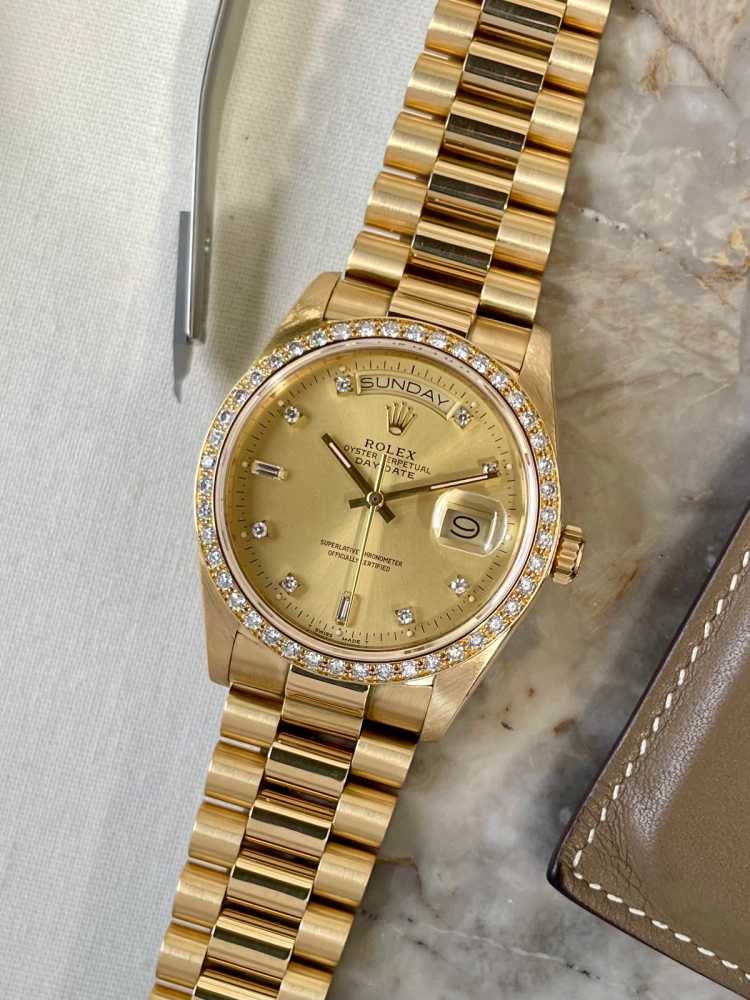
Buy with confidence. 300+ 5 star reviews on Google and Chrono24
What diamonds does Rolex use?
Ever wondered what kind of diamonds the worlds best-know watch manufacturer uses?
Ever wondered what kind of diamonds the worlds best-known watch manufacturer uses? It should come as no surprise that Rolex only uses the best diamonds. Besides selecting the best diamonds they also use some expert diamond setting techniques to ensure that each diamond sparkles just that little bit more.

The quality of the stone
To know what the quality really means we dive a bit deeper in how the quality of a diamond is measured. Diamonds are rated for four qualities: cut, color, clarity and carat.
The cut
A diamond in the rough isn’t real pretty to look at. To make it shine a rough diamond needs to be cut. The quality of the cut can really make or break the quality of the end product. The cut of the diamond is rated on how well proportioned each facet of the stone is. These proportions determine how well the diamond is able to capture light. The most known cut is the brilliant cut, which you also mostly see on Rolex models. A more rare cut is the baguette, a long and thin shape, which Rolex also uses as hour-markers, seen for example at 6 and 9 o'clock on the below Rolex 18048.
The color
Diamonds come in different colors, ranging from D to Z. Where D is completely colorless and Z is lightly colored. Rolex only uses the most colorless diamonds ranging from D to G. It’s believed that for the white gold and platinum models they only select the colors D and E.
The clarity
Or the purity of the diamond. Diamond is a natural material and often has some impurities on the inside or the outside of the stone. The clarity is graded from FL (flawless) to I3 (many or very large inclusions). Rolex only uses diamonds that are internally flawless (IF) or better. These diamonds look perfect to the naked eye and even when inspected under a 10X magnifying microscope.
The carat
Probably the most known quality of a diamond. But it is nothing more than a simple measurement of a diamond’s weight.

Rolex diamond setting techniques
The quality of the diamond is important, but the way it's set can also make or break the stones ability to capture light. Of course Rolex does this like no other and uses four traditional diamond setting techniques to secure the diamonds and let them sparkle.
On most Rolex dials with diamond indexes we find the ‘claw’ setting technique. The diamond is held in place by 4 gold claws around the corners of the stone. This way the light capturing ability of the stone isn’t obstructed by the metal that holds it in place. Channel setting is most commonly used on bezels with baguette-cut diamonds. Here stones with the same size are placed in a track or channel and are kept in place between the sides of the channel. Whenever Rolex uses round diamonds on the dial or a bezel these are set in a Closed setting. Here a metal band surrounds the diamond to keep it in place.
Or as Rolex describes it:
“The process begins by sourcing the most striking stones and then deciding how best to showcase them, as the art of gem-setting lies in ensuring that the sparkle and beauty of each stone is fully revealed”
A Rolex with diamonds is probably not for everyone. We think it can really add something extra to a watch without being in your face or too blingy. Especially when the diamonds are used only on the dial as hour markers.
